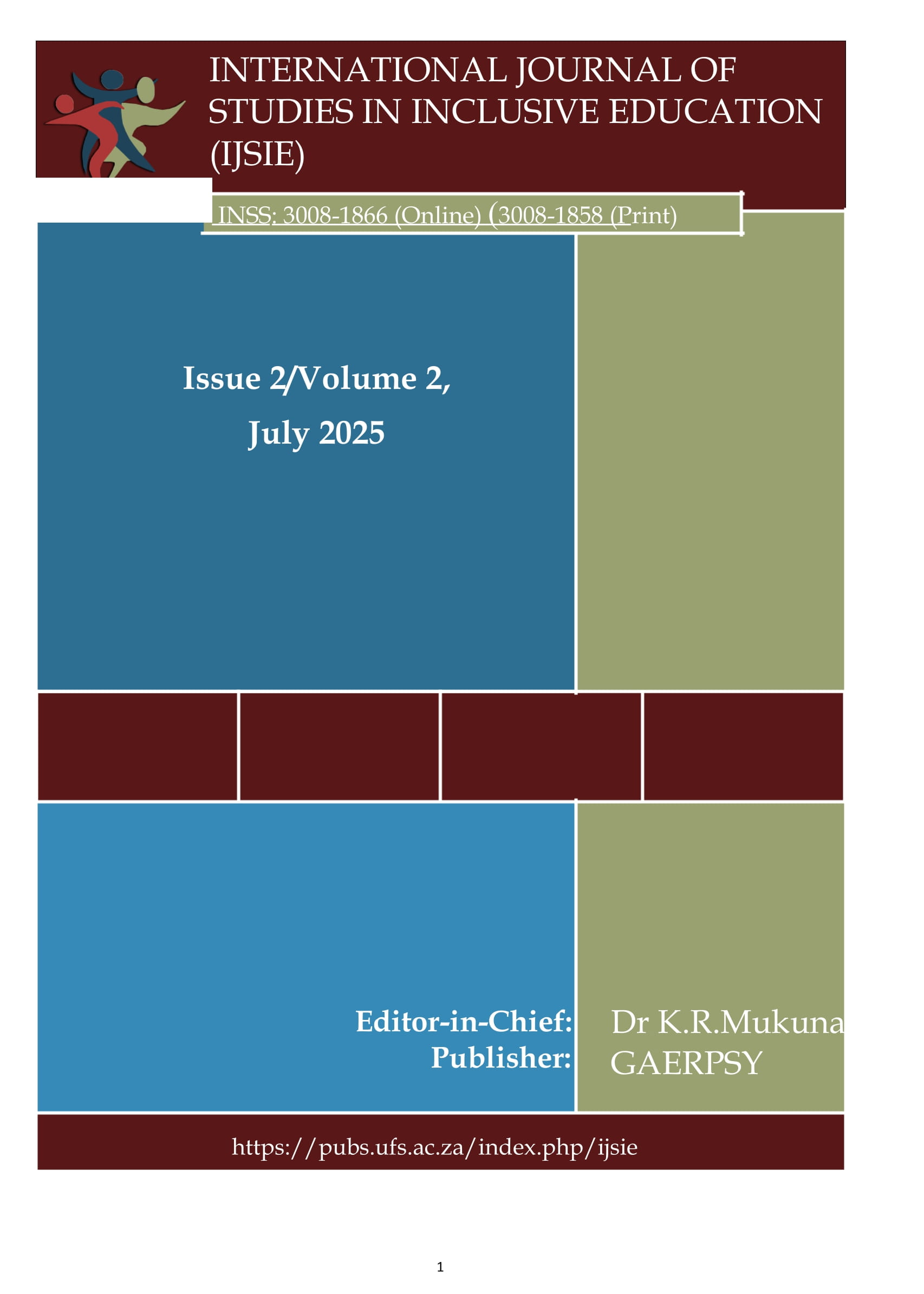Home and school environment as determinants of internet addiction among adolescents with hearing impairment in Ibadan Oyo state, Nigeria
DOI:
https://doi.org/10.38140/ijsie.v2i2.1957Keywords:
Adolescent, Internet addiction, Hearing impairment, Parental attitude, Peer influenceAbstract
Adolescent students have been addicted to the internet, and students with hearing impairment are not left out. Excessive use and uncontrollable internet are among the ills, despite being a communication tool for students with hearing impairment. The study, therefore, evaluated the home and school environment as determinants of internet addiction among adolescents with hearing impairment in Ibadan. The correlational type of survey research design was adopted for the study, and eighty-one (81) adolescents with hearing impairment in Ibadan were the participants from three secondary schools. Research instruments adopted were Internet Addiction, home environment, and peer pressure inventory scales. These were used to answer three research questions raised for the study. The data collected from the study were analysed using frequency count, percentages, Pearson product-moment correlation (PPMC), and regression analysis. The study revealed a significant relationship between the home and school environment on internet addiction among adolescents with hearing impairment, the school environment, and the home environment. It also revealed that there was a joint contribution of home and school environment to internet addiction among adolescents with hearing impairment R 0.715. Furthermore, the study revealed the relative contribution of home and school environment to internet addiction, where the school environment exerts more influence on internet addiction than the home environment. It indicated that parental attitudes and peer influence had a positive influence on internet addiction among adolescents with hearing impairment. Based on the findings, it was recommended that parents with children with hearing impairment should improve their communication and interaction with their children by learning effective communication modes with their wards, and the school authority should ensure that the school environment is friendly enough for adolescents with hearing impairment to thrive in without any form of intimidation.
References
Andreassen, C. S., Torsheim, T., Brunborg, G. S., & Pallesen, S. (2012). Development of a Facebook addiction scale. Psychological Reports, 110(2), 501-517. https://doi.org/10.2466/02.09.18.PRO.110.2.501-517
Armsden, G. C., & Greenberg, M. T. (1987). The Inventory of Parent and Peer Attachment: Individual differences and their relationship to psychological well-being in adolescence. Journal of Youth and Adolescence, 16(5), 427-454. https://doi.org/10.1007/BF 02202939
Ayyagari, R., Grover, V., & Purvis, R. (2011). Technostress: Technological antecedents and implication. MIS Quartely, 35(4), 831-858. https://doi.org/10.2307/41409963
Beard, K. W. (2005). Internet addiction: A review of current assessment techniques and potential assessment questions Cyber Psychology & Behaviour, 8(1), 7-10. https://doi.org/10.1089/cpb.2005.8.7
Boneva, B. S., Quinn, A., Kraut, R. E., Kiesler, S. B., & Shklovski, I. (2006). Teenage communication in the instant messaging era. In R. E. Kraut, M. Brynin, & S. Kiesler (eds.), Computers, phones and the internet: Domesticating information technology (pp. 201-218). Oxford: Oxford University Press.
Boyd, D. M., & Ellison, N. B. (2007). Social network sites: Definition, history, and scholarship. Journal of Computer-Mediated Communication, 13(1), 210-230. https://doi.org/10.1111/j1083-6101.2007.00393.x
Bryer, T. A., & zavattaro, S. M. (2001). Social media and public administration: Theoretical dimensions and introduction to the symposium. Administrative Theory & Praxis, 33(3), 325-340. https://doi.org/10.27 53/ATP1084-1806330301
Cho, C. H., & Cheon, H. J. (2005). Children's exposure to negative Internet content: Effects of family context. Journal of Broadcasting & Electronic Media, 49(4), 488–509. https://doi.org/10.1207/s15506878jobem4904_6
Cooper, A., Rose, J., & Mason, O. (2004). Measuring the attitudes of human service professionals toward deafness. American Annals of the Deaf, 148(5), 385-389. https://doi.org/10.1353/aad.2004.0001
Craig, O. (2003, February 9). Chat mates watched Internet suicide. The Telegraph. Retrieved from https://www.telegraph.co.uk/news/main.jhtml?xml=/news/2003/02/09/wsuic09.xml
Dalessandro, A. M., & Chory-Assad, R. M. (2006, June). Comparative significance of parental versus peer mediation of adolescents’ antisocial video game play. Paper presented at the Annual Meeting of the International Communication Association, Dresden, Germany.
Davis, R. A. (2001). A cognitive-behavioral model of pathological Internet use. Computers in Human Behavior, 17(2), 187-195. https://doi.org/10.1016/S0747-5632(00)00041-8
Debatin, B., Lovejoy, J. P., Horn, A. K., & Hughes, B. N. (2009). Facebook and online privacy: Attitudes, behaviors, and unintended consequences. Journal of Computer-Mediated Communication, 15(1), 83-108. https://doi.org/10.1111/j.1083-6101.2009.01494.x
Griffiths, M. D. (1996). Internet “addiction”: An issue for clinical psychology? In Clinical Psychology Forum (Vol. 97, pp. 32-36). Nottingham, England: Nottingham Trent University. https://doi.org/10.53841/bpscpf.1996.1.97.32
Gross, E. F. (2004). Adolescent internet use: What we expect, what teens report. Journal of Applied Developmental Psychology, 25(6), 633-649. https://doi.org/10.1016/j.appdev.2004.09.005
Ha, J. H., Kim, S. Y., Bae, S. C., Bae, S., Kim, H., Sim, M., ... & Cho, S. C. (2007). Depression and Internet addiction in adolescents. Psychopathology, 40(6), 424-430. https://doi.org/10.1159/000107426
Helsen, M., Vollebergh, W., & Meeus, W. (2000). Social support from parents and peers and emotional problems in adolescence. Journal of Youth and Adolescence, 29(3), 319-335. https://doi.org/10.1023/A:1005149101954
Huang, X., Zhang, H., Li, M., Wang, J., Zhang, Y., & Tao, R. (2010). Mental health, personality, and parental rearing styles of adolescents with Internet addiction disorder. Cyberpsychology, Behavior, and Social Networking, 13(4), 401–406. https://doi.org/10.1089/cyber.2009.0213
Isaiah O. (2011). Home Environment Scale. University of Ibadan Bookshop, Ibadan.
Isaiah O. (2011). Peer Inventory Scale. University of Ibadan Bookshop, Ibadan.
Kuss, D. J., & Griffiths, M. D. (2011). Online social networking and addiction: A literature review of empirical research. International Journal of Environmental Research and Public Health, 8(9), 3528-3552. https://doi.org/10.3390/ijerph8093528
Lenhart, A., Rainie, L., & Lewis, O. (2001). Teenage life online [Report]. Washington, DC: Pew Internet & American Life Project.
Lin, C. H., Lin, S. L., & Wu, C. P. (2009). The effects of parental monitoring and leisure boredom on adolescents' Internet addiction. Adolescence, 44(176), 993–1004.
Maier, C., Laumer, S., Eckhardt, A., & Weitzel, T. (2015). Giving too much social support: Social overload on social networking sites. European Journal of Information Systems, 24(5), 447-464. https://doi.org/10.1057/ejis.2014.3
Mesch, G. S. (2003). The family and the Internet: The Israeli case. Social Science Quarterly, 84(4), 1038–1050. https://doi.org/10.1046/j.0038-4941.2003.08404016.x
Nathanson, A. I. (2001). Parent–child perspectives on the presence and meaning of parental television mediation. Journal of Broadcasting & Electronic Media, 45(2), 210–220. https://doi.org/10.1207/s15506878jobem4502_1
Ni, X., Yan, H., Chen, S., & Liu, Z. (2009). Factors influencing Internet addiction in a sample of freshman university students in China. CyberPsychology & Behavior, 12(3), 327–330. https://doi.org/10.1089/cpb.2008.0321
Pempek, T. A., Yermolayeva, Y. A., & Calvert, S. L. (2009). College students’ social networking experiences on Facebook. Journal of Applied Developmental Psychology, 30(3), 227–238. https://doi.org/10.1016/j.appdev.2008.11.010
Peter, J., Valkenburg, P. M., & Schouten, A. P. (2005). Developing a model of adolescent friendship formation on the Internet. CyberPsychology & Behavior, 8(5), 423-430. https://doi.org/10.1089/cpb.2005.8.423
Quan-Haase, A., & Young, A. L. (2010). Uses and gratifications of social media: A comparison of Facebook and instant messaging. Bulletin of Science, Technology & Society, 30(5), 350–361. https://doi.org/10.1177/0270467610380009
Quittner, A. L., Barker, D. H., Cruz, I., Snell, C., Grimley, M. E., Botteri, M., & CDaCI Investigative Team. (2010). Parenting stress among parents of deaf and hearing children: Associations with language delays and behavior problems. Parenting: Science and Practice, 10(2), 136-155. https://doi.org/10.1080/15295190903212851
Richards, R., McGee, R., Williams, S. M., Welch, D., & Hancox, R. J. (2010). Adolescent screen time and attachment to parents and peers. Archives of pediatrics & adolescent medicine, 164(3), 258-262. https://doi.org/10.1001/archpediatrics.2009.280
Seidman, G. (2013). Self-presentation and belonging on Facebook: How personality influences social media use and motivations. Personality and Individual Differences, 54(3), 402-407. https://doi.org/10.1016/j.paid.2012.10.009
Shepherd, R. M., & Edelmann, R. J. (2001). Caught in the web. The Psychologist, 14(10), 520–521.
Sim, T., Gentile, D. A., Bricolo, F., Serpelloni, G., & Gulotta, G. (2012). A conceptual review of research on the pathological use of computers, video games, and the Internet. International Journal of Mental Health and Addiction, 10(5), 748-769. https://doi.org/10.1007/s11469-011-9369-7
Siomos, K., Floros, G., Fisoun, V., Dafouli, E., Farkonas, N., Sergentani, E., …, & Geroukalis, D. (2012). Evolution of Internet addiction in Greek adolescent students over a two-year period: The impact of parental bonding. European Child & Adolescent Psychiatry, 21, 211-219. https://doi.org/10.1007/s00787-012-0264-3
Virtanen, T., & Malinen, S. (2008). Supporting the sense of locality with online communities. MindTrek '08: Proceedings of the 12th international conference on Entertainment and media in the ubiquitous era (pp. 145-1489). Tampere, Finland: Association for Computing Machinery. https://doi.org/10.1145/14257199.1457231
Wartella, E. A., Lee, J. H., & Caplovitz, A. G. (2002). Children and interactive media: Research compendium update. Markle Foundation.
Wellman, B., Haase, A. Q., Witte, J., & Hampton, K. (2001). Does the Internet increase, decrease or supplement social capital? Social networks, participation, and community commitment. American Behavioral Scientist, 45(3), 436-455. https://doi.org/10.1177/00027640121957286
Xiuqin, H., Huimin, Z., Mengchen, L., Jinan, W., Ying, Z., & Ran, T. (2010). Mental health, personality, and parental rearing styles of adolescents with Internet addiction disorder. Cyberpsychology, Behavior, and Social Networking, 13(4), 401–406. https://doi.org/10.1089/cyber.2009.0222
Xu, Z., Turel, O., & Yuan, Y. (2012). Online game addiction among adolescents: Motivation and prevention factors. European Journal of Information Systems, 21(3), 321-340. https://doi.org/10.1057/ejis.2011.57
Yen, C. F., Ko, C. H., Yen, J.-Y., Chang, Y. P., & Cheng, C. P. (2009). Multi-dimensional discriminative factors for Internet addiction among adolescents regarding gender and age. Psychiatry and Clinical Neurosciences, 63(3), 357-364. https://doi.org/10.1111/j.1440-1819.2009.01969.x
Yen, J.-Y., Ko, C.-H., Yen, C.-F., Wu, H.-Y., & Yang, M.-J. (2009). The comorbid psychiatric symptoms of Internet addiction: Attention deficit and hyperactivity disorder (ADHD), depression, social phobia, and hostility. Journal of Adolescent Health, 45(1), 93-98. https://doi.org/10.1016/j.jadohealth.2008.12.002
Young, K. S. (1998). Internet addiction: The emergence of a new clinical disorder. Cyberpsychology & behavior, 1(3), 237-244. https://doi.org/10.1089/cpb.1998.1.237
Yu, J. J., & Gamble, W. C. (2010). Direct and moderating effects of social affordances on school involvement and delinquency among young adolescents. Journal of Research on Adolescence, 20(4), 811–824. https://doi.org/10.1111/j.1532-7795.2010.00668.x
Additional Files
Published
How to Cite
Issue
Section
License
Copyright (c) 2025 Omowunmi Oyadoyin

This work is licensed under a Creative Commons Attribution-NonCommercial-NoDerivatives 4.0 International License.
All articles published by GAERPSY Publishing are under an Attribution-NonCommercial-NoDerivatives 4.0 International (CC BY-NC-ND 4.0) license, allowing author (s) to share copies and redistribute the material in any medium or format. The GAERPSY Publishing cannot revoke these freedoms if they follow the license terms:
• Attribution: Author (s) must give appropriate credit, provide a link to the license, and indicate if changes were made. Author (s) may do so reasonably but not in any way that suggests the licensor endorses his/her or thier use.
• NonCommercial: Author (s) may not use the material for commercial purposes.
• NoDerivatives: If author (s) remixes, transforms, or builds upon the material, he/she (they) may not distribute the modified material.
• No additional restrictions: Author (s) may not apply legal terms or technological measures that legally restrict others from doing anything the license permits.








